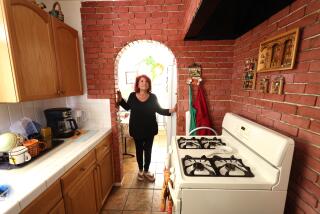Porcelain Signs From ‘70s Are Aging Gracefully
- Share via
Dear Street Smart:
I have a historical question: Why do the signs posted on different freeways look different? For instance, I really like the pink and pastel green signs posted on the Orange Freeway between the Riverside Freeway and the Orange Crush. Why can’t they put those on the Santa Ana Freeway in Anaheim and throughout?
Signs in the early ‘70s looked neat and beautiful. In the San Francisco and Oakland area they have nice colored signs in the ‘70s-style color scheme. Would that paint chemistry be too expensive to duplicate if you installed the metallic colored sign posts? Will they have those installed in Anaheim when the Santa Ana Freeway is widened?
R.C. Aba Jr.
Anaheim
The ‘70s-style signs you refer to will never be installed again because the company that made them went out of business in the mid-1970s.
For those confused by your question, here’s the scoop.
As long as anyone can remember, says Jim Drago, a Caltrans spokesman, the signs on the state’s freeways have been in three basic colors: green for directional signs, yellow for caution signs and red for restrictive or regulatory signs such as “Wrong Way, Do Not Enter.”
Made out of porcelain enamel by a company called Cameo, Drago said, the signs were “like one of those old 1930s bathtubs. You could scrub it and nothing would ever happen. They would last and last and last.”
About 1975, it was discovered that the manufacture of the porcelain signs produced pollution. Rather than go through the expensive process of changing its operations, Drago said, the company shut down. So Caltrans contracted another company to build freeway signs using baked enamel, basically a kind of paint.
The problem is that the newer painted signs oxidize and become discolored after a while, while the older porcelain signs tend to hold their hue. The color seems different on different freeways, depending on how old the signs are.
The bottom line is that the old signs you love will gradually be replaced by the new signs to which you are indifferent.
Regarding the pink color you mention, according to Drago, it is caused by the oxidation of the buttons used to form the letters on the old porcelain signs. That too will disappear with those old signs.
Dear Street Smart:
I have been having a hard time lately adjusting to the cars that have running lights, especially at night. The running lights are brighter than the standard headlights, and when cars come up from behind, all four of them totally blind you.
For me to keep my high beams on all the time would not only get me a ticket, but also a lot of angry motorists. What can be done to control this running light problem?
Jerry Wallin
Laguna Niguel
Not a heck of a lot, says Steve Kohler, a spokesman for the California Highway Patrol.
Daytime running lights, now factory installed on some new cars, were developed after studies showed that leaving car lights on during the day can increase visibility and reduce accidents. The lights, which are mounted in front but are separate from the standard headlights, automatically go on every time the car is driven.
California law does prohibit more than four lights on the front of a car and strictly regulates their height, focus and strength, Kohler said. Most factory-installed lights meet the legal specifications.
His suggestion is to get out of the way.
“If I’m driving along and someone comes up behind me with really bright headlights that are bothering me,” Kohler said, “the first thing I do is try to move over. If I can’t do that, I adjust the inside rear-view mirror to minimize the light coming in and, at the next available point, pull over and let them go by.”
Dear Street Smart:
When sound walls are added along freeways, such as the San Diego Freeway several years ago and those recently built on the Costa Mesa Freeway, do the owners of the residential properties behind the walls get the benefit of using the land up to the new walls?
Some walls are built immediately adjacent to existing fences, but other walls appear to have as much as 10 or 15 feet of space between existing fences.
Doug BennettTustin
Those property owners do not get to use the land unless they make a special request to Caltrans which, in most cases, owns the land in question.
When that happens, said Maureena Duran-Rojas, a Caltrans spokeswoman, the agency will investigate the property to determine if there are any utility lines running through it, plans for future construction on it or other reasons that it should remain vacant. If nothing turns up, Duran-Rojas said, then Caltrans will offer the property to the nearby owner at its market value.
Street Smart appears Mondays in The Times Orange County Edition. Readers are invited to submit comments and questions about traffic, commuting and what makes it difficult to get around in Orange County. Include simple sketches if helpful. Letters may be published in upcoming columns. Please write to David Haldane, c/o Street Smart, The Times Orange County Edition, P.O. Box 2008, Costa Mesa, CA 92626, send faxes to (714) 966-7711 or e-mail him at David.H[email protected]. Include your full name, address, and day and evening phone numbers. Letters may be edited, and no anonymous letters will be accepted.
More to Read
Sign up for Essential California
The most important California stories and recommendations in your inbox every morning.
You may occasionally receive promotional content from the Los Angeles Times.










